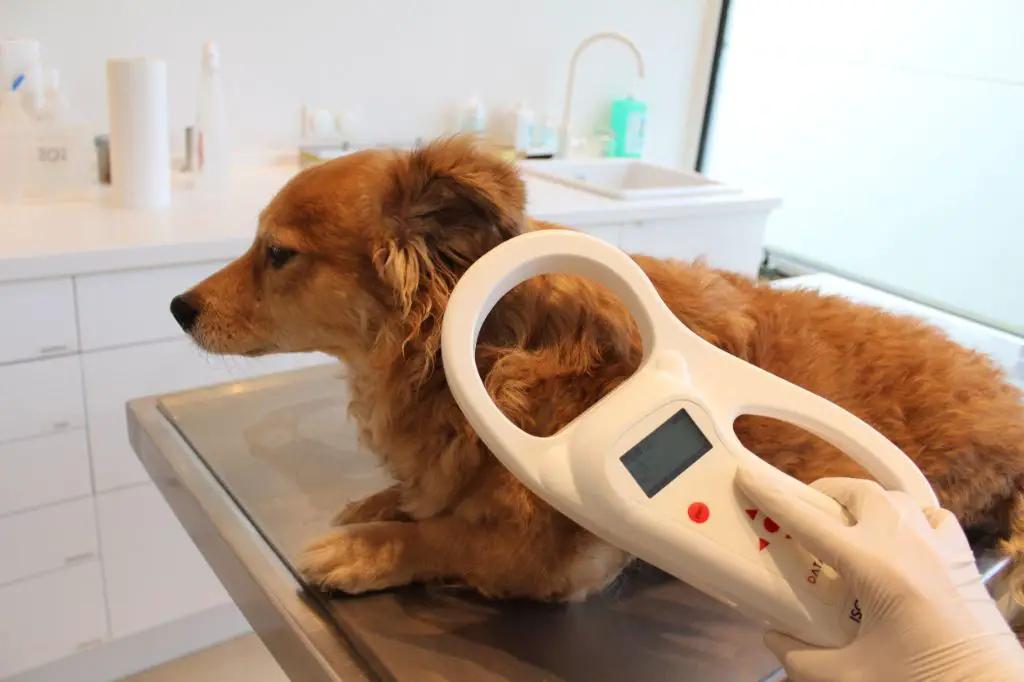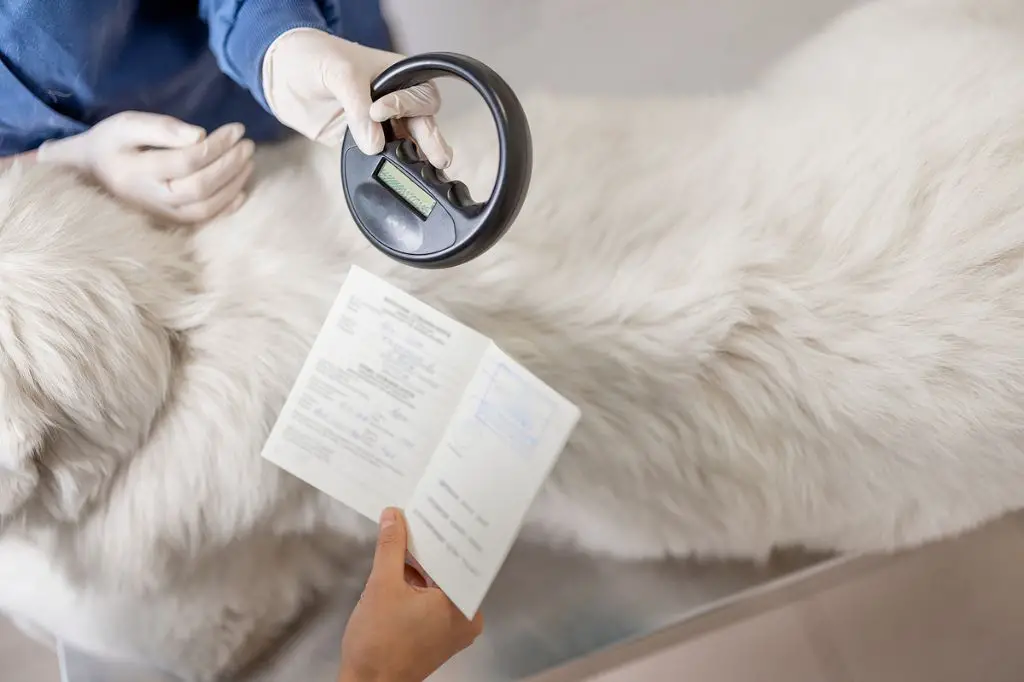What is a Microchip?
A microchip is a tiny chip, about the size of a grain of rice, that contains a unique identification number. The microchip itself does not contain any personal information about the dog or owner. It simply serves as a way to identify the dog if it gets lost.
The microchip is inserted under the skin, usually between the dog’s shoulder blades. It’s injected with a syringe and the process is very quick and simple. Once inserted, the microchip lasts for the lifetime of the dog.

Microchips are primarily used to identify lost dogs and reunite them with their owners. If an unidentified dog comes to an animal shelter or vet clinic, they will scan it for a microchip to get the dog’s unique ID number. This allows them to look up the owner’s contact information in the microchip registration database.
It’s important to understand that a microchip is not a GPS tracker. It does not actively track the dog’s location or allow you to find your dog if it runs off. The microchip only provides the dog’s ID when scanned at close range. Having current registration information linked to the microchip is crucial for it to effectively help identify your lost dog.
Why Microchip Your Dog?
Microchipping provides your dog with a permanent ID that can help reunite you if they ever get lost or separated from you. Unlike collars and tags, which can fall off or be removed, a microchip is implanted under your dog’s skin, so it stays with them no matter what. Here are some of the key reasons to microchip your pup:
Permanent ID if collar/tags lost – Collars and ID tags can easily fall off or be removed, leaving your dog unidentified. But a microchip stays with your dog permanently. So even if the collar is lost, your contact information remains associated with your pet.
Reunite lost dogs with owners – If your lost microchipped dog ends up at an animal shelter or vet’s office, staff can scan the chip to get your contact information and call you. Microchips greatly improve the chances lost dogs make it back home.
Required by some shelters/boarding – Many animal shelters and boarding facilities now require dogs to be microchipped before they will accept them. So it ensures your dog has permanent ID in case of separation or loss.
How to Check if Your Dog is Microchipped

There are a couple ways to check if your dog has a microchip implanted. The most straightforward method is to part the fur at the shoulder blades and feel for a small bump about the size of a grain of rice. This is where veterinarians and shelters implant the microchip between the shoulder blades. If you feel a small bump, there’s a good chance your dog is microchipped.
However, the only way to confirm the presence of a microchip is to scan your dog with a microchip scanner. Most veterinary offices and animal shelters have universal scanners to detect and read microchips from any manufacturer. Bring your dog to a vet or shelter and ask them to scan for a microchip. If a microchip is detected, they will be able to provide the unique identification number. You can then use this microchip ID to verify if it’s registered or to complete the registration.
Verify the Microchip Registration
Once you have located your dog’s microchip and obtained the identification number, you can verify that the microchip is properly registered by contacting the microchip company.
To verify registration, you will need to provide the microchip company with your dog’s unique ID number. This is usually a 10 to 15 digit number that can be found on the microchip itself or on your dog’s paperwork from when they were initially chipped.
Call or email the microchip company and provide them with the microchip ID number. The customer service representative will then look up your dog in their database and confirm whether your information is on file. They should be able to tell you the name, address, phone number, and email address that is currently associated with your dog’s microchip.
Take this opportunity to confirm that all of the contact information in your dog’s microchip registration is current and up-to-date. Providing accurate owner information is crucial because the microchip registry is what will be used to identify and contact you if your lost dog turns up at an animal shelter or vet clinic. If any of your details such as your name, address, or phone number have changed, be sure to update the information in the registry.
Following up periodically to double check that your details are correct will help ensure you can be reached if your dog ever becomes lost. Having an unregistered or out-of-date microchip registration defeats the purpose of microchipping your pet in the first place.
Register an Unregistered Microchip
If your vet or shelter scans your dog and finds an unregistered microchip, you will need to register it under your name and contact details. Here are the steps:

1. When the vet or shelter scans your dog, they should be able to provide you with the unique ID number encoded in the microchip.
2. Contact the microchip company associated with that ID number. The vet/shelter may be able to look up the company based on the ID. Or you can find contact info for major microchip companies like HomeAgain, 24PetWatch, or Avid online.
3. Provide the company with the ID number and your contact information. There will likely be a small fee to complete the registration transfer process.
4. The microchip company will update their records to list you as the registered owner attached to that chip. Be sure to confirm the change went through.
Now if your dog ever gets lost, shelters will be able to scan the microchip and contact you directly as the registered owner. Keeping your details updated with the microchip company is essential to quickly reuniting with your pet.
Transfer Registration to New Owner
When you get a new dog that already has a microchip, you’ll want to update the registration to show that you are now the owner. This ensures you can be contacted if your dog ever becomes lost.
To transfer the registration, first get signed proof of ownership from the previous owner. This provides legal documentation showing that you are the new lawful owner of the dog. Have the previous owner sign a document that includes your contact details, your dog’s microchip number, and acknowledges that you are now the rightful owner.
Next, contact the microchip registration company and submit the proof of ownership documentation. Follow their procedures to transfer the registration over to you. Provide your name, address, phone number and other contact details.
Once submitted, the microchip company will update their records to show you as the registered owner. Be sure to confirm the transfer is complete by calling the microchip company. Now if your dog ever becomes lost, you can be reached as the owner.
Update Your Contact Information
It’s important to keep your contact information up-to-date with your dog’s microchip registration. If your dog ever becomes lost, the microchip company or animal shelter will use the contact info on file to get your dog back home safely.

Be sure to notify the microchip company if you move or change phone numbers. Most registries allow you to easily update your address and phone online or through their mobile app. You’ll need to provide the microchip number or registered pet ID to access and edit your account info.
In addition to your own contact details, check that any alternative or emergency contacts are current. These secondary contacts can be crucial in case the primary owner is unavailable or unreachable. Keeping emergency contact details like phone numbers and email addresses up-to-date improves the likelihood your dog is returned if lost.
Making a habit of periodically checking in and confirming your details are correct only takes a few minutes. Taking this simple step lets you relax knowing your microchip registration is current, and your dog has the best chance of quickly making their way back home if they become lost.
Microchip Registration Services
There are several reputable national registries that provide microchip registration services for pet owners in the United States:
24PetWatch
24PetWatch is one of the largest pet recovery databases in the United States and Canada. When you register your pet’s microchip with 24PetWatch, your contact information is stored in their database and can be accessed 24/7 by shelters and veterinary clinics to reunite lost pets.
Found Animals Registry
Found Animals Registry operates a searchable online database linked to microchips from all major manufacturers. There is no charge to register your pet or to search for a lost pet in their database.
HomeAgain
HomeAgain is one of the most widely-used pet recovery services in the U.S. They offer both free and premium plans for registering your pet’s microchip information. With a HomeAgain membership, you can also access additional benefits like lost pet rewards and veterinary care discounts.
You can register your pet’s microchip with the service recommended by your veterinarian who implanted the chip. Most veterinary clinics work with one of the major national registries and can easily register the chip for you right after implantation.
Microchipping Cost
The cost to microchip a dog ranges from $25-$50 if done at your veterinarian’s office. Some veterinary clinics or shelters may hold low-cost microchipping events periodically where the cost is reduced. This initial microchip implantation fee covers the physical microchip itself and the registration process.
In addition to the upfront cost of getting your dog microchipped, most microchip companies charge an annual or lifetime membership/registration fee. This helps cover the database maintenance and customer service required to keep your pet’s records up-to-date. Lifetime registration fees are typically $15-$25.
Microchipping Laws
Many cities and counties in the United States require dogs to be microchipped by law. These municipal microchipping laws are intended to increase the likelihood of lost or stray dogs being reunited with their owners.
Typically, microchipping is required at the time a dog is licensed. For example, Los Angeles County requires pet owners to provide proof of microchip identification before issuing a license.
Some local microchipping laws only apply under certain circumstances, such as adopting from an animal shelter or being deemed a dangerous or potentially dangerous dog.
In addition to local governments, many animal shelters and dog boarding facilities mandate microchip identification as a condition of releasing or accepting dogs. Having your dog microchipped ensures you will comply with any laws or policies requiring proof of ownership.
Pet owners should research microchipping requirements specific to their city, county, or state. Staying current on local laws allows ample time to get a new dog microchipped or confirm an existing microchip is registered and up-to-date before any deadlines.